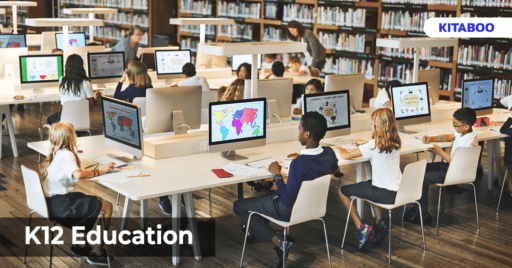
Incorporating Technology in the Classroom: A Guide for K12 Educators
Summarize this blog with your favorite AI:
Traditional teaching methods no longer seem to deliver learning experiences and outcomes that reflect the times. With the chalk & talk method becoming gradually redundant, K12 educators need to make a drastic change. One solution is to begin teaching with technology.
Integrating technology into the classroom, changes the classroom dynamic. While students gain more control over their learning, the role of the educator becomes more of that of a facilitator.
However, this change can be challenging for some. Whether it’s the lack of resources and support or whether it’s due to other reasons altogether, our guide will help demonstrate how to get started on incorporating technology in the K12 classroom. Here’s what we’ll cover.
Table of Contents
- Why Use Technology in the K12 Classroom?
- How to Integrate Technology into the K12 Classroom?
- Age-Wise Strategies to Incorporate Technology in the K12 Classroom
Why Use Technology in the K12 Classroom?
Some argue that teaching with technology can distract the students, especially those who are prone to being addicted to technology. However, we believe that the monitored use of technology in K12 organizations can be far more beneficial than detrimental.
Here’s why:
Higher Engagement Levels
Students today tend to have a very short attention span. Without an engaging learning method, keeping their attention focussed can be difficult. Technology brings in interactive elements that grabs their attention, keeping them focussed and engaged with the learning material.
Caters To Different Learning Styles
Not all children learn in the same way and at the same speed.
With technology, lesson plans can be customized as per each individual’s ability. This ability to cater to different learning styles, gives students the flexibility to learn at their own pace.
Brings Out Creativity
The wonders of technology can encourage students to stretch their imaginations. By allowing them to use it to create their own versions of what they learn, students can explore newer ways of expressing themselves. Educators too, have a plethora of options with regard to how they would like to deliver their lessons.
How to Integrate Technology in Your K12 Classroom?
For those of you still on the fence about teaching with technology, here’s a look at ways to integrate it in your classrooms, along with some insights into the possible outcomes.
Gamify the Learning Experience
Children of all ages love games. Games teach them problem-solving and collaboration skills and can be an effective way to boost engagement in the classroom.
There are many ways you can use gaming to supercharge the blended learning experience. For instance, you can split students into groups and send them off on a digital scavenger hunt, where they can collect pictures, make videos, or hunt online for facts related to a particular topic.
Similarly, you can create quizzes, puzzles, ciphers, and multiple-choice questions related to a chapter and have students answer these via their devices. Gamified learning experiences are known to keep students engaged and improve their retention of the subject being taught.
Implement Differentiation Through Tech
Differentiated instruction programs are becoming increasingly popular. They are a student-centric approach to learning i.e. – They take into consideration the differing learning abilities of each student and tailor lesson plans accordingly.
In the classroom, this could mean educators adapt the content they are teaching, to suit different needs. They could also choose whether to teach the entire class together or break them up into smaller groups. Similarly, how students present their learnings can also be differentiated.
With technology, implementing this approach becomes easier.
Build a Classroom Website
Building a website dedicated to a single classroom, is an easy way to integrate technology. Students can be involved in the creation of the website to make it fun and engaging. The site can then house subject-matter content for everyone to access anytime, anywhere.
While at it, assignments and homework can also be posted online. This will make them accessible to all and help students stay organized.
Posting class activities and homework online can also be valuable for parents and administrators to monitor what’s happening in the classroom.
You could also have a classroom blog where students can post essays, articles or begin discussions.
Have an Online Grading System
Another important area where technology can be an enabler is communication. Start an online grading system that facilitates easy communication between teachers, parents, administrators, and students.
Teachers can post grades, attendance, and transcripts online, making it easy for all to access and analyze. It will help monitor a students’ progress over time.
Age-Wise Strategies to Incorporate Technology in the K12 Classroom
Teaching with technology opens us up to a range of possibilities. However, keep in mind that its implementation will vary for different age groups.
Let’s explore how.
For Elementary Students
Using technology in elementary school can help students build fundamental skills and prepare them for future independent learning.
Educators can incorporate interactive games that help children explore basic mathematical concepts and improve their phonetics, reading, and spelling or reasoning skills.
You can also add your own word lists to improve vocabulary and pronunciation among children.
For Middle School Students
For middle schoolers, technology should be used with a focus on teaching them essential life skills and developing their critical thinking abilities.
For instance, you can teach them how to conduct internet research, find credible sources, and cite them in their work to avoid plagiarism.
For High School Students
At this stage, students need to explore all that they can do with technology.
Open-ended projects and assignments will give them the freedom to use technology in ways that suit them best. They also need to be able to find and analyze content effectively. Giving them online research-oriented assignments will help.
To Conclude
Taking small steps to integrate technology into your K12 classroom can reap many benefits for students and bring their learning to life. Depending on your resources, you can discover various ways of teaching with technology. The above examples are only the tip of the iceberg!
Further, if you’re looking for a digital publishing platform that allows you to create, publish and distribute interactive eBooks and other K12 content, KITABOO could be your ideal choice.
Our intuitive platform supports several media formats and offers various interactive features, such as annotation tools, read-aloud capabilities, search, social learning, etc., to enhance learning outcomes.
You can seamlessly integrate your eBook with audio, videos, images, and activities for interactive learning. We also enable active note-sharing between educators and learners.
To know more, write to us at contact@kitaboo.com.
Discover how a mobile-first training platform can help your organization.
KITABOO is a cloud-based platform to create, deliver & track mobile-first interactive training content.

![Top 5 Free Publishing Sites for Independent Publishing [2026]](https://kitaboo.com/wp-content/uploads/2025/09/Top-5-Free-Publishing-Sites-for-Independent-Publishing-2026-420x235.webp)
